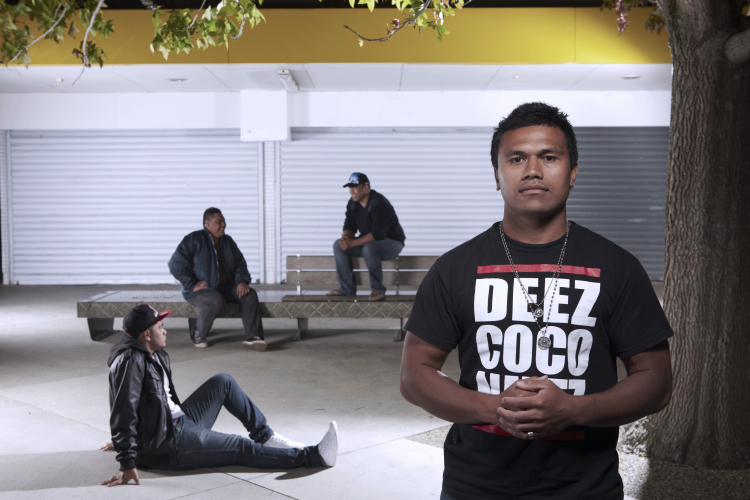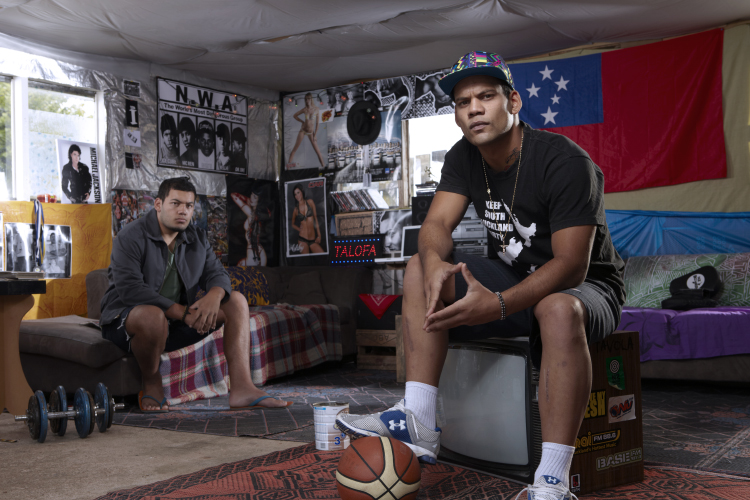Silent Figures
A Photographic Portfolio by Tanu Gago
DANIEL M. SATELE

TANU GAGO ‘Leo’ (Jerry The Fa’afafine) 2010 Colour photograph
Tanu Gago is not a photographer. A conceptual artist, Gago worked with technicians, models and others to realise the photographic works that comprise his series Jerry the Fa’afafine (2010) and Avanoa o Tama (2012). Devoid of candidness, these photographs lie beyond the conventional boundaries of documentary. The contents of each frame have been carefully set-up and artificially lit, with the artist directing the subjects’ dress and poses. Yet, while these shots are staged (some to the point of farcicality), resembling commercial photography, in published commentary and informal discussion alike, the key feature of Jerry and Avanoa is virtually always identified as being their reference to a certain reality: that stereotypes and received expectations affect the lives of urban Pacific young men, whilst, in a semi-obscure yet undeniably related manner, one’s identity is tied to one’s spatial location. Also unanimously voiced is the assertion that Gago’s photographic works do more than simply reference this social reality, that they moreover alter or contest an element of the social status quo. Jerry and Avanoa seem to attract to themselves the application of verbs ― ’subvert’, ‘challenge’, ‘provoke’, ‘advocate’, ‘explore’ ― suggesting that Gago’s photographic works are somehow active, acting on the world into which Gago has brought them. I’ve heard it suggested numerous times that the activity Jerry and Avanoa perform is broadcasting a usually silent, or unheard, voice; or the blazoning of a usually invisible, or overlooked, reality.
In our thinking about Jerry and Avanoa we can do better than the customary nods to cultural reference and subversive political effects. If Jerry and Avanoa articulate a reality, a truth, it is a complex one. This truth does not appear in ‘real life’, in the sense that Gago’s strategy for articulating it is to stage elaborate set-ups. Yet, if the truth articulated here does not appear on the surface of everyday social life, awaiting capture by casual snapshot, we must nonetheless refrain from assuming that this means Gago’s photographs communicate the truth of a hidden depth, the truth of a secret fraternity for exotic, erotic strangers. Silence and stillness are intrinsic to the photograph, and it must be significant that Gago has found photography to be the correct medium for rendering as artworks the concepts he sought to engage with Jerry and Avanoa. The subjects of these images do not speak. All are close-mouthed. If these young men say anything it is without words. For all the narrative Gago expertly implies here, it seems to me that the truth to which these works actually refer is one of absence. Real holes in discourse lie at the hearts of Jerry and Avanoa: that which remains unsaid, or cannot be said, at certain times or in certain places, between certain people, or ever at all. Perhaps we lose what Jerry and Avanoa have to offer us when we rush to conclude we have received the message these silent figures send us.

TANU GAGO ‘Pati’ (Avanoa O Tama) 2012 Colour photograph

TANU GAGO ‘Lupeni’ (Avanoa O Tama) 2012 Colour photograph

TANU GAGO ‘Peter + William’ (Avanoa O Tama) 2012 Colour photograph

TANU GAGO ‘Jermane + Mesha’ (Avanoa O Tama) 2012 Colour photograph

TANU GAGO ‘Cody + Joel’ (Avanoa O Tama) 2012 Colour photograph
